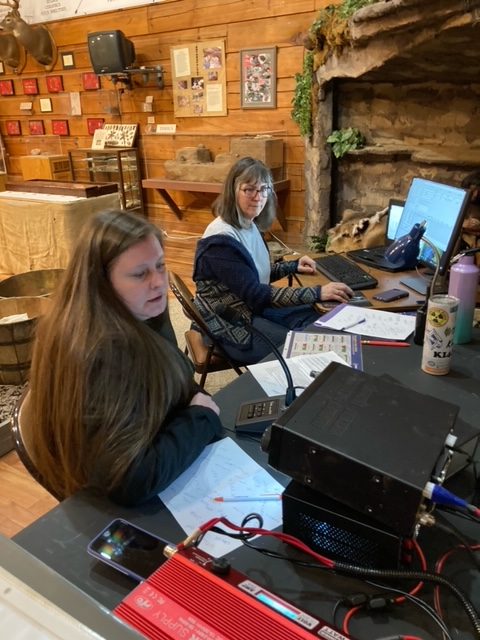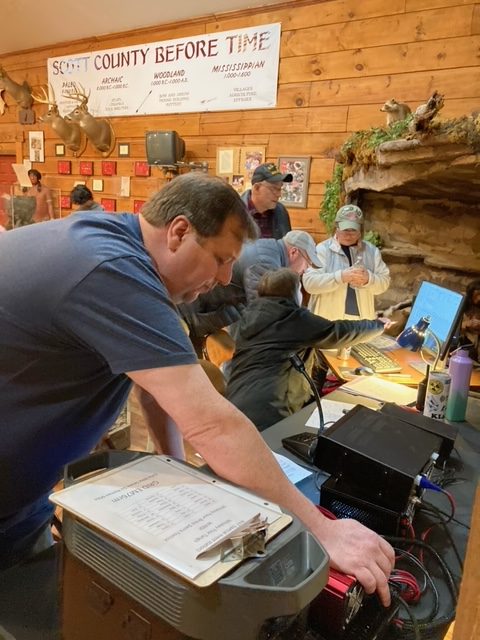
USS Tennessee Special Event Station
February 25-26th 2022
The USS Tennessee Battleship Museum special event station was held on February 25 th and 26 th 2022 to recognize the 75 th anniversary of the ship’s decommissioning. This was the first special event station hosted by The Big South Fork Amateur Radio Club (https://bsfarc.org/) an ARRL affiliated club and the first activation at the museum as well. Planning for the event started during the summer of 2021 when the club reached out to the director of the museum with the idea for the special event activation. The goals for the event were simple with the main objective to raise awareness of the USS Tennessee Museum and educate others on the history of the ship. The secondary goal was to have a live event educating the public about amateur radio and the Big South Fork Amateur Radio Club. It would also serve as a practice session at setting up temporary amateur radio stations in a unique environment.
Prior to the event the club promoted the event on social media, local papers, and the local radio stations. The estimated outreach went to approximately 200,000 people and the club responded to inquiries from the United Kingdom as amateur radio operators were looking forward to contacting the USS Tennessee special event station. A local AM/FM public radio station attended the event with a live broadcast and interviewed the sponsors from the museum in addition to members from the amateur radio club.
Due to the size of the museum and nature of the artifacts on display, numerous challenges had to be overcome during the planning stages. The available open floor space in the USS Tennessee Museum would only allow for a small table to be placed with just enough room for the radio, computer for logging of contacts and the two radio operators. It was fortunate that another museum building was located next door that had ample floor space for an additional two radio stations. Being a museum there were no windows as that would allow the sun to shine in which would affect the artifacts on display. This required that the feedlines run through doorways in a safe manner. Electrical power was very limited in both museums as well requiring heavy duty extension cords plugged into different circuits to prevent overloads and to reduce any induced noise into the circuits.
Installation of the antennas also proved a challenge as the area had received about five inches of rain the day before the event making the grass to the side of the museum very soft and muddy. Attempts were made to install a ground mounted tripod and mast, but the assembly would just sink and topple over. Guy wires were ineffective as the screw anchors would not work in the muddy ground. The team improvised and ended up with the tripod adjacent to the building sloping away to the far end where it was attached to another museum structure. The antenna for the FT8 station ran from the museum’s porch sloping up to a nearby tree. At the USS Tennessee Museum the end-fed wire antenna was supported by the flagpole in an inverted V sloping down the railing on the porch and to the roof rack of a member’s truck in the parking lot.
The club had two stations set up for phone/SSB and the plan was to work different bands in addition to an FT8 station that would be more flexible in band selection. The secondary station served as a GOTA (Get On The Air) station with multiple operators present. Since the museums are located on the campus of Scott High School, teachers brought students to witness and participate in the event. After a quick overview of amateur radio, the club’s spokesperson explained more about the special event station and the radio equipment. Students were invited to make contacts with the help of the control operator. The team coached and students practiced reading the script after listening to the team making contacts. While a little nervous at first, the students did a great job and were excited to learn the locations of their contacts. Teachers and the museum’s director also took a turn at making a contact or two.
The event was a success with over 600 contacts made including 48/50 states and just missed WAS (Worked All States) missing contacts in Wyoming or Delaware. The reach of amateur radio allowed the operators to promote the museum and history of the USS Tennessee to contacts around the world including those located in: Azores, Canada, China, Corsica, Ecuador, England, France, Germany, Hungary, Japan, Panama, Puerto Rico, Scotland, Spain, and the US Virgin Islands. The event reached A total of 15 countries with over 250 confirmed contacts on QRZ as the club could not upload to LoTW (Logbook of The World) under the special event call sign. The club sent about 150 QSL (amateur radio for confirmation) certificates and received many QSL cards in the mail as well.
Overall, the Big South Fork Amateur Radio Club considered the event very successful as every goal was exceeded. The museum’s director asked when they would like to do another special event station at the museum. Over 150 volunteer hours were recorded during the two-day event with many more in preparation and for the follow-up tasks. For more information about the club and to see some of the behind-the-scenes photos check out their website at https://bsfarc.org/index.php/uss-tennessee-special-event-station/. The club website also has a link to the Museum of Scott County, home of the USS Tennessee Battleship Museum.

Above is a sample QSL certificte that was issued as part of the special event station

Kelly (KI4JAV) in the foreground is making another contact while Nancy (KC8VTT) in the background logs the information on the computer


